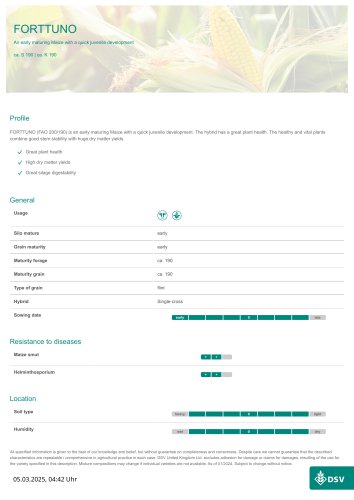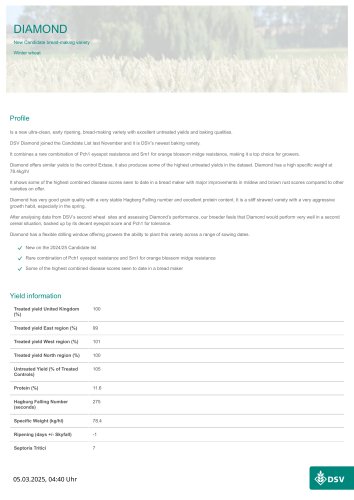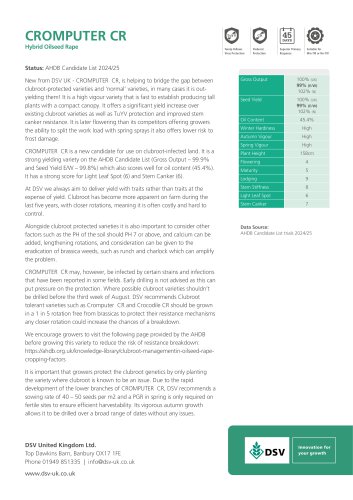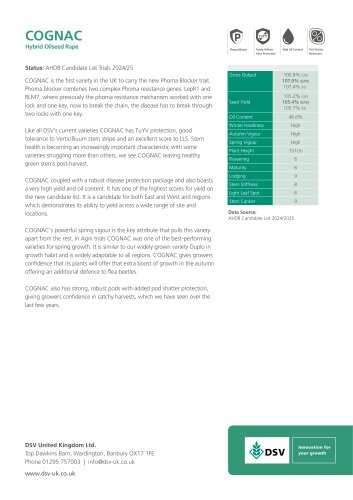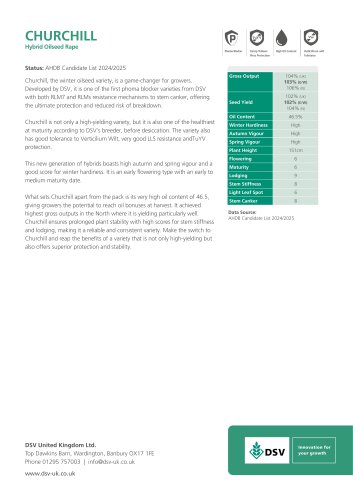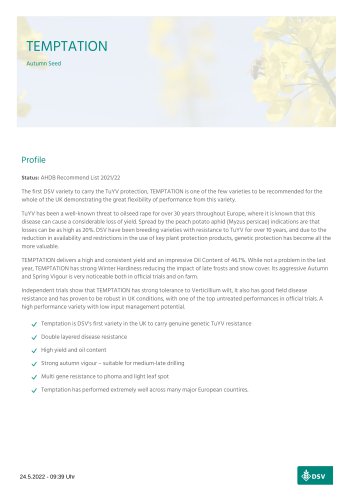
Catalog excerpts
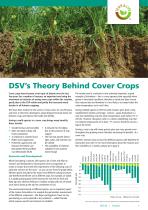
DSV’s Theory Behind Cover Crops Cover crops have become a hot topic of debate over the last few years for a number of reasons, an important one being the movement to inclusion of spring sown crops within the rotation, partly due to the CAP reform and partly the increased weed burden in all Autumn cropping. The variety used in a mixtures is also extremely important, a good example is Buckwheat – this is a very vigorous plant especially when grown in favourable conditions, therefore a variety has been chosen that matures later and therefore it is less likely to set seeds before the cooler temperatures set in and it dies. DSV have been involved in the science of crop covers for over 90 years, and have, in that time, developed a range designed to break down soil between crops and improve the health and fertility. Having multiple species in DSV TerraLife mixtures gives both a long establishment window and longer survival – again, Buckwheat is a very fast establishing crop but when temperatures reach below 3°C it will die. However, Hungarian vetch is a slower establishing crop that can tolerate temperatures of at least -7°C and can therefore survive a typical UK winter. Having a cover crop with many species gives you more ground cover throughout the growing season therefore increasing the benefits of a cover crop. The environmental needs of different species are an important aspect of the mixture formulation. For example the germination requirements of the different component – like Niger and Egyptian Clover are dry germinating so can be planted in dry conditions – unlike Phacelia which requires warmth and moisture to establish. Field Beans Egyptian Clover Persian Clover Cromson Clover White Clover Fodder Cabbage When formulating a mixture, DSV spend a lot of time and effort in research and development, choosing the correct components to create a mixture that meets the requirements of the following crop. Of particular concern are the roots – as you can see from the graph below, different plants included in the mixes have different rooting structures and therefore benefit the soil in different ways. For example, oil radish is a rapidly growing plant which loosens the soil with its thick and deep tap root, whereas field pea is shallow rooting with lots of lateral roots which break up the top few centimetres of soil. All DSV’s mixtures have at least five different species with MaizePro DT having the most with 13, for more information about the mixtures and their suitability in a rotation, please go to page 4. White Mustard • reduced risk of lodging A due to the provision of crop support • fact that growth factors The light, water and nutrients can be utilised • availability of material The suitable for late autumn/ winter forage • Greater biomass and root yields • More microbial activity and humus production • A reduction in nutrient losses • Better weed suppression • Protection against pest and diseases like Potato Cyst Nematodes (PCN) and Beet Cyst Nematodes (BCN) Having a multi-species in a cover crop brings many benefits, these include: 90 120 150 180 210 240 270 ■ Main root mass ■ Maximum root depth Source: Prof. Dr. W. Buchner, Im Sommer ist Zeit für die Bodensanierung, Landwirtschaftliches Wochenbla
Open the catalog to page 1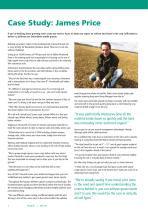
Case Study: James Price If you’re thinking about growing cover crops you need to focus on what you expect to achieve and invest in the crop sufficiently to deliver it, believes one Oxfordshire arable grower. Building up organic matter in his predominantly Cotswold brash soil is a key priority for Woodstock producer James Price but it’s not one without challenge. Using up to 10,000 tonnes of FYM per year on his 460ha Perdiswell Farm is the starting point but increasingly he’s focusing on the use of high output cover crop mixes to add nutrients and bulk to his relatively thin calcareous...
Open the catalog to page 2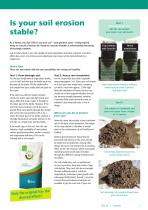
Is your soil erosion stable? As a farmer, you don’t like to see your soil – your greatest asset – being washed away as a result of heavy rain. However, extreme weather is unfortunately becoming increasingly common. Test 1 Flow-through test Add the soil sample, pour water over and watch Crop rotation with TerraLife Maize monoculture Just to what extent is your soil capable of water absorbtion and water retention, and what effect does cover crop mixtures and undersown crops have, can be demonstrated by a simple test. Here’s how There are two simple and low-cost possibilities for testing soil...
Open the catalog to page 3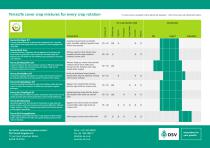
TerraLife cover crop mixtures for every crop rotation If a certain variety is unavailable it will be replaced with equivalents . (X) not to be used in soils effected with clubroot. A balanced mixture of legumes and non-legumes to fix nitrogen and leave behind a good tilth. It also enriches the soil with humus and improves the soils health for the following crop particularly in intensive crop rotations. field pea, squarrose clover, Persian clover, serradella, phacelia, niger, buckwheat, sunflower, common vetch field pea, forage rye, crimson clover, phacelia, sunflower, Persian clover,...
Open the catalog to page 4
The new CAP reform comes into effect this year and includes the need to have 5% of your arable area under 'Greening'. One of the ways you can fulfil this criteria is by planting a catch or cover crop*. DSV has developed two mixtures which will meet the new rules. *Catch crop - sown by 31 August, in the ground until at least 1 October Cover crop - sown by 1 October, in the ground until at least 15 January Vetch/Rye Late autumn greening cover crop mix This mixture gives good ground cover, protecting the soil going into the winter from erosion. The two species in the mixture have different...
Open the catalog to page 5
Order Form Name: Farm Address: Delivery Address: Phone number. Please note: All mixtures are packed in 25kg or bulk bags and for quantities under 450kg an additional haulage charge may be incurred. We would like to put this order through a merchant, please could you specify your preference: Please send the completed form to DSV United Kingdom Ltd 17 Lynn Road, Downham Market, Norfolk PE36 9NJ or phone your order through on 01366388223
Open the catalog to page 6All DSV UK catalogs and technical brochures
-
FORTTUNO
2 Pages
-
DIAMOND
2 Pages
-
CROMPUTER CR
1 Pages
-
COGNAC
1 Pages
-
CHURCHILL
1 Pages
-
Spring Oilseed Rape
6 Pages
-
SENDERO
2 Pages
-
ARMAN
2 Pages
-
DART
1 Pages
-
MIRACULIX CL
3 Pages
-
PINACO
3 Pages
-
LOXTON
2 Pages
-
BEATRIX CL
3 Pages
-
DUKE
2 Pages
-
DOLPHIN
2 Pages
-
DEVIL
2 Pages
-
CROCODILE CR
3 Pages
-
EXPEDIA
3 Pages
-
Darling
3 Pages
-
LAGONDA
2 Pages
-
LUMEN
2 Pages
-
MENTHAL CR
2 Pages
-
THEODORE
4 Pages
-
LIROYAL
5 Pages
-
INCENTIVE
2 Pages
-
CLICK CL
2 Pages
-
OLYMPUS
2 Pages
-
MOVANNA
3 Pages
-
LIKEIT
5 Pages
-
PLURAX CL
2 Pages
-
Temptation
3 Pages
-
Verticillium Wilt Tolerance
2 Pages
-
Product Guide
27 Pages
-
Harvest Update
1 Pages
-
Clearfield
2 Pages
-
BetaMaxx DT
1 Pages
-
Dualis
1 Pages
-
Dariot
2 Pages


